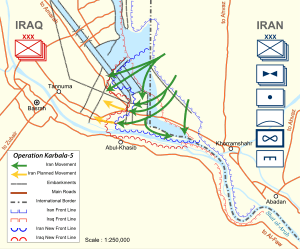Siege of Basra
| Siege of Basra Operation Karbala-5 | |||||||||
|---|---|---|---|---|---|---|---|---|---|
| Part of the Iran–Iraq War | |||||||||
 | |||||||||
| |||||||||
| Belligerents | |||||||||
|
|
| ||||||||
| Commanders and leaders | |||||||||
|
|
| ||||||||
| Units involved | |||||||||
|
3rd Corps
7th Corps[6] National Defense Battalions |
Basij and Revolutionary Guards (70%): | ||||||||
| Strength | |||||||||
| 300,000 (four armies) | 150,000–200,000 (six divisions from army & rest from the Basij militia) | ||||||||
| Casualties and losses | |||||||||
|
20,000 casualties [7] 45 aircraft[7] |
65,000 casualties[7] Unknown loss of materiel | ||||||||
| ≈2 million civilians displaced | |||||||||
The Siege of Basra, code-named Operation Karbala-5 (Persian: عملیات کربلای 5), was an offensive operation carried out by Iran in an effort to capture the Iraqi port city of Basra in early 1987. This battle, known for its extensive casualties and ferocious conditions, was the biggest battle of the war and proved to be the beginning of the end of the Iran–Iraq War.
Bibliography
- The Great War for Civilisation: The Conquest of the Middle East, by Robert Fisk, Knopf Books, 2005
- "The Gulf Iran Strikes on Two Fronts", by William E. Smith, Time, 26 January 1987
- "The Gulf", Time, 2 February 1987
- "The Gulf Life Among Smoldering Ruins", by Dean Fischer, Time, 30 March 1987
- In The Name of God: The Khomeini Decade, by Robin Wright, Simon and Schuster, 1989
- Essential Histories: The Iran–Iraq War, 1980–1988, by Efraim Karsh, Osprey Publishing, 2002
- Journey to Heading 270 Degrees, by Ahmad Dihqan and Paul Sprachman, Mazda Publishers, 2006
- The Longest War, by Dilip Hiro, Routlage Chapman & Hall, 1991.
- http://csis.org/files/media/csis/pubs/9005lessonsiraniraqii-chap08.pdf
- https://books.google.com/books?id=dUHhTPdJ6yIC&printsec=frontcover&source=gbs_atb#v=onepage&q&f=false
References
- 1 2 3 Colonel Jafari, Mojtaba (2006). "Chapter 6: Sixth year, Seizing Faw". Atlas of Unforgettable Battles. Tehran: Operations Holy Defence Research Center. p. 133. ISBN 964-06-5515-5.
- ↑ Pelletiere, Stephen C (10 December 1990). Lessons Learned: Iran–Iraq War. Marine Corps Historical Publication. p. 40.
- ↑ Hoffpauir, Michael E. (June 1991). "Tactical Evolution in the Iraqi Army: The Abadan Island and Fish Lake campaigns of the Iran-Iraq War" (PDF). Ft. Leavenworth, Kansas: U.S. Army Command and General Staff College: 104. Retrieved 5 September 2012.
- 1 2 3 4 5 Woods, Kevin M. (2011) [2010]. Saddam's Generals: Perspectives of the Iran–Iraq War. 4850 Mark Center Drive, Alexandria, Virginia: Institute for Defense Analyses. p. 73.
- 1 2 "/خاطره اختصاصی محسن رضایی از کربلای ۵/". خبرگزاری فارس.
- ↑ Hoffpauir, Michael E. (June 1991). "Tactical Evolution in the Iraqi Army: The Abadan Island and Fish Lake campaigns of the Iran–Iraq War" (PDF). Ft. Leavenworth, Kansas: U.S. Army Command and General Staff College: 94. Retrieved 5 September 2012.
- 1 2 3 John Pike. "Iran-Iraq War (1980-1988)".
External links
Coordinates: 30°30′00″N 47°48′00″E / 30.5000°N 47.8000°E
This article is issued from
Wikipedia.
The text is licensed under Creative Commons - Attribution - Sharealike.
Additional terms may apply for the media files.